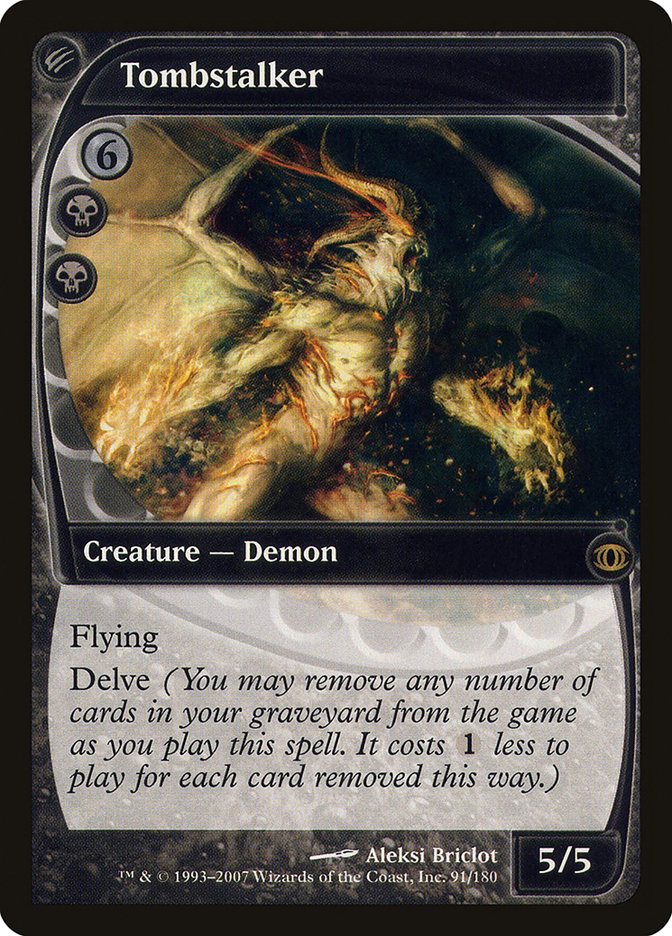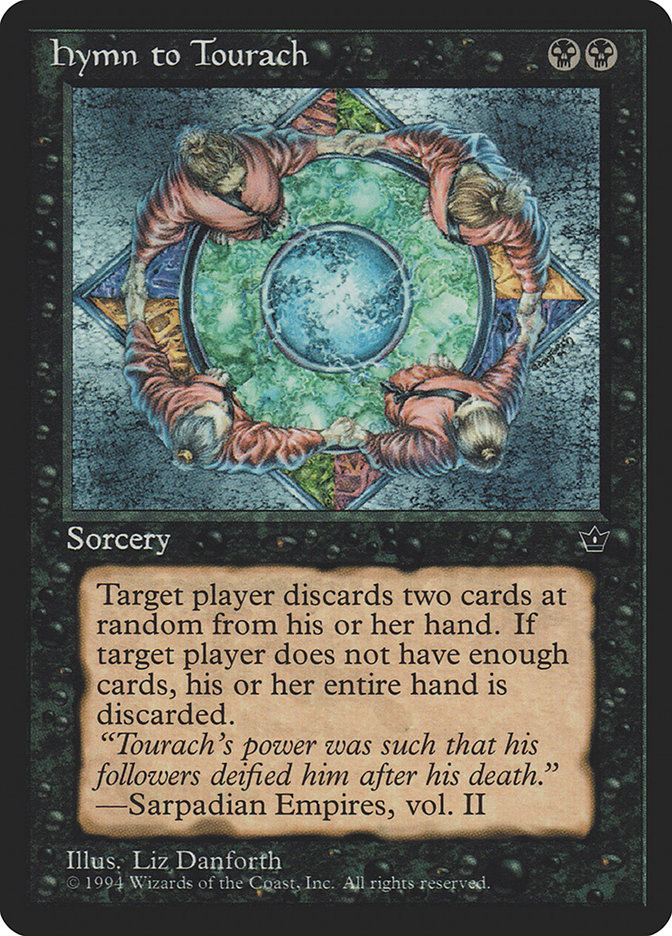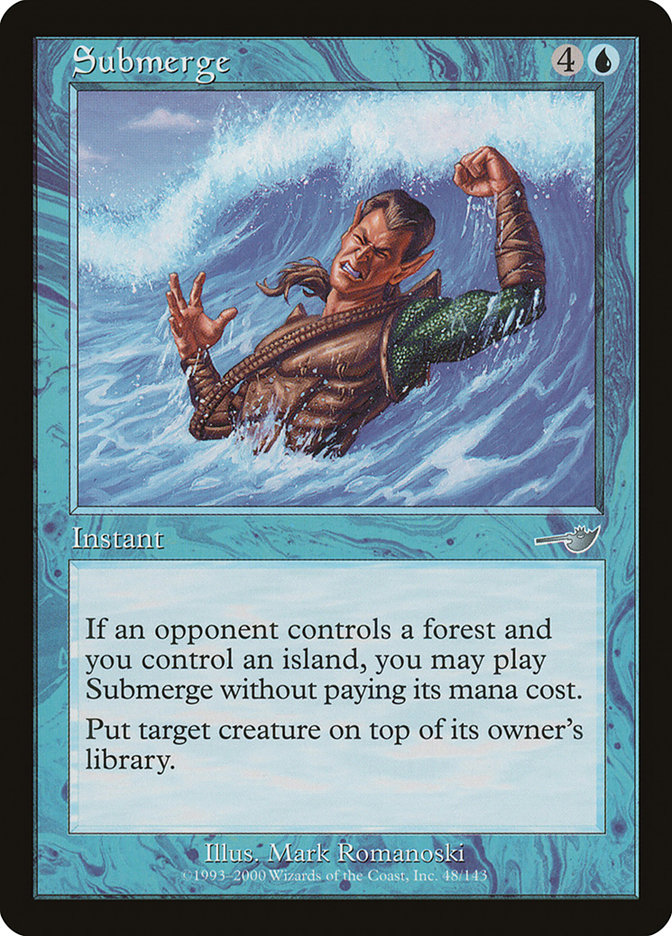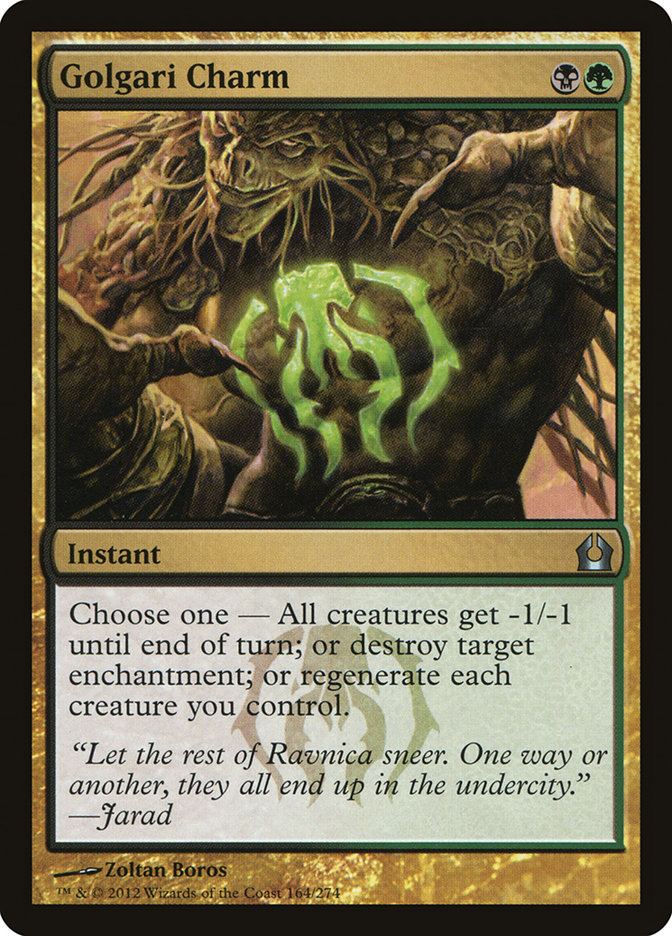I finally made it! After a near-miss in Baltimore back in August, unintentionally drawing with Brian Braun-Duin in round 9, being able to win game three on what would have been turn six of extra turns… when a win would put me in at eighth place, and another near miss in Providence (coming in 9th!), I finally made it into a Legacy Open Top 8. I want to thank everybody that has helped me out along the way, including the people from London who helped me get started, the folks from New Hampshire/Massachusetts and of course, Curio Cavern in Springfield, VA. I want to share with you my past experiences with Legacy and also talk about my current deck of choice.
I’m just going to go out and say it. I think BUG Delver is the best deck in Legacy. Things might change after Spirit of the Labyrinth shakes up the format, but since the printing of True-Name Nemesis (and, indeed, for a while before that), I think BUG Delver has been one of the most criminally-underplayed decks in all of Legacy’s history. Compared to the other top decks in the format, BUG Delver offers just an unparalleled level of consistency and raw nut draw power. Now, anybody who finds a lot of success with one particular archetype is bound to think they have might have found one of the best decks in the format. They may be right or they may be wrong, but in a format filled with as much strategic diversity like Legacy, how can there possibly be a “best deck?” Why am I convinced that I’m right?
I have to backtrack a little bit to tell the full story. I’ve been playing Legacy since 2010, and I’ve played over 9,000 games of Legacy (holy crap is that a scary thought). I know the format incredibly well and like to conduct my own metagame analysis to figure out what decks are doing well. I also have a spreadsheet keeping track of all of my matches, so I can figure out how certain match-ups are skewed. I’ve played each of the following decks for over a hundred games: RUG Delver, U/W/R Delver, BUG Delver, Merfolk, U/R Delver, Four-Color Delver, Affinity, Esper Deathblade, Miracles, The Epic Storm, Ad Nauseam Tendrils, and Sneak and Show. In addition, I’ve played almost every other relevant Legacy deck (Esper Stoneblade, Death and Taxes, Shardless BUG, Omni-Tell, Reanimator, and Dredge) to at least five match wins just to see how they ticked. So I have a little bit of perspective.
I began my exploration into paper Legacy with Affinity back in 2011, which was a bit underpowered and didn’t have Brainstorm. As soon as I could, I moved into the Magical Christmasland of blue and started playing Hive Mind, and I had considerable success with the archetype due to Mental Misstep. After Misstep was banned, I eventually went on to build Sneak and Show and enjoyed winning 19 out of 20 matches I played with it at a local gaming store with it this past summer. Good as that was, I eventually stopped playing the deck and switched over to Delver decks after losing more matches to my own dead draws than I wanted to. Show and Tell has the inherent weakness that certain cards are completely dead when they’re sitting in your hand, and there are just too many times where the deck is unable to consistently get through a nine-round tournament without pooping on itself at least once. That’s why I believe great Sneak and Show players like William Huey Jensen and Jared Boettcher have dropped out of recent tournaments in early rounds.
Later that summer, I moved to the Northern Virginia area and began playing at a store called Curio Cavern. To say the Legacy scene there was competitive would be a huge understatement – dozens of players there have SCG Top 16s to their name, and a few of them have GP Top 8s and SCG trophies as well. After playing there for a couple weeks, I noticed a pattern. One man in particular, Dan Signorini, almost always finished 4-0 and served as the final boss. In a room full of winners, he simply dominated week in and week out with his baby, BUG Delver. For the first couple of months, I chalked it up to him being a phenomenal player (which he admittedly is), but eventually I decided I wanted to try it out myself. I promptly went 4-0 for the very first time after many 3-1s. The deck is incredibly consistent and plays almost all of the best spells in Legacy. According to Mtgdecks.net, it literally plays 9 of the 10 most-played cards in Legacy (not counting fetchlands or dual lands). Brainstorm, Force of Will, Ponder, Wasteland, Daze, Swords to Plowshares, Spell Pierce, Deathrite Shaman, Abrupt Decay and Delver of Secrets make up the top ten, in case you were wondering.
Here’s what I played in Baltimore:
Creatures (14)
Planeswalkers (2)
Lands (20)
Spells (24)
Sideboard

A few explanations:


This won’t surprise many, but Deathrite Shaman is either the best or second-best creature in Legacy (Stoneforge Mystic would be the only other card that is close). A one-mana planeswalker that disrupts the graveyard while providing you with a mana advantage is simply unfair, and games when you begin with a Deathrite Shaman can spiral out of control quickly when your deck is full of cheap, efficient spells and eight copies of the most powerful card-selection cantrips ever printed. I would almost always lead with Deathrite Shaman if possible, as untapping with three mana on turn two available simply gives you more options and allows you to deploy more threats and disruption.
The main threats of the deck are chosen for their impressive power-to-mana cost ratio, but Tombstalker bears some additional explanation. Swords to Plowshares and Jace are the only two commonly-played maindeck spells that efficiently answer Tombstalker, and in all other situations versus the fair decks he has free reign over the skies and is nigh-unkillable. Given your deck runs plenty of other threats as well as a healthy resource denial package, Tombstalker can often finish off opponents before they find an answer. He also does a great job of trumping Legacy’s new boogeyman, True-Name Nemesis.
All of BUG Delver’s threats close games quickly, and I think this is one inherent advantage that can’t be understated. Stoneforge Mystic takes multiple turns to set up, but Tarmogoyf and Delver just beat face.


We don’t have the efficiency of Lightning Bolt or Swords to Plowshares here, but we trade that efficiency for utility. The ability to destroy Chalice of the Void, Rest in Peace, and any equipment besides Batterskull is very relevant, and the uncounterability is fantastic versus opposing Delver decks. Legacy is an extremely wide open format, and Abrupt Decay is one reason why BUG Delver has game against everything.
And instead of Stifle, we have an automatic two-for-one that can still occasionally screw the opponent like Stifle does by hitting their lands. Stifle is inherently situational and can be played around; the only situation where Hymn does nothing is when their hand is gone. Unlike other Delver decks, BUG Delver relies on the “tap out” method of generating tempo, where every single turn you are trying to use your mana efficiently. That means disrupting your opponents with Hymn and Wasteland then closing out the game quickly with your efficient beaters. Great against both fair decks and combo, Hymn has been far superior to Thoughtseize. Deathrite Shaman into Wasteland + Hymn is a common opening line that is ridiculously unfair. Chaining Hymns is often an easy way into a free win, and the card is almost always a must-counter when it’s played in the early turns of the game, so I would prioritize playing it as soon as possible. Hymn to Tourach also allows BUG Delver to grind effectively against the midrange/control strategies in the format.


Spell Pierce is the most efficient counterspell against combo decks, and I play it over Flusterstorm because it’s much more versatile and counters problems like Sneak Attack and Blood Moon that Flusterstorm can’t answer. In general, I would not side it in against Jace decks unless they are running very few creatures as well.
And Submerge simply breaks one of the most fundamental rules of magic by giving you a free pseudo-removal spell at no cost whatsoever. I wanted this card to deal with RUG Delver, Elves and the mirror. If BUG Delver gets more popular, this is one of the few cards in the mirror that can stop Tombstalker, so I would consider additional copies.
BUG Delver’s primary weakness is that it lacks cheap removal spells for must answer threats (Deathrite Shaman, Stoneforge Mystic, Mother of Runes etc.) and Disfigure kills almost everything we care about. In general, other decks with Deathrite Shaman can be very clunky if you manage to kill their one mana land/planeswalker, so it’s a very high priority to do so. If Tombstalker catches on, I may play a couple Dismember instead, but the life loss is relevant enough that I currently prefer Disfigure.
Sylvan Library is bananas vs. other fair decks and offers you unparalleled card selection and card advantage. I never want to sit across from one, and the disgruntled look on your opponent’s face when they realize they don’t have an answer to your Library is very telling of its raw power. Library is only weak when you’re behind against a tempo or combo deck where you can’t afford to tap out. Ideally, I would try to find a spot for it in the main, but Liliana is so strong right now I prefer her.
 Golgari Charm is one of the most versatile sideboard tools BUG Delver has right now. Killing multiple creatures from Death and Taxes, Elves and UR Delver as well as answering Empty the Warrens would make for a decent sideboard card by itself. But in conjunction with the ability to counter Supreme Verdict and the ability to destroy Rest in Peace and Sneak Attack, Golgari Charm is over the top. It has a lot of overlap with Krosan Grip against Esper Stoneblade decks, so I am currently running two copies of each.
Golgari Charm is one of the most versatile sideboard tools BUG Delver has right now. Killing multiple creatures from Death and Taxes, Elves and UR Delver as well as answering Empty the Warrens would make for a decent sideboard card by itself. But in conjunction with the ability to counter Supreme Verdict and the ability to destroy Rest in Peace and Sneak Attack, Golgari Charm is over the top. It has a lot of overlap with Krosan Grip against Esper Stoneblade decks, so I am currently running two copies of each.
I opted not to play any graveyard hate this time around, as I felt as though Dredge is really under-represented, Reanimator is beatable without graveyard hate and boards into 4 Show and Tells anyway to beat any hate cards, and Loam strategies are also very beatable with Deathrite Shaman + a counterspell for their Punishing Fire. If graveyard decks continue rising in popularity, I’ll probably pack some copies of Nihil Spellbomb / Grafdigger’s Cage / Surgical Extraction.
With that, I’ll give some highlights from my tournament.
Round 3 – Jack Kitchen with Imperial Painter (2-1)
Game 1:
Jack is the first of five opponents that I play today that end up X-2 or better. He used to live in the NoVa area, and used to play at Curio. I distinctly remember certain stories told about him, but I could not for the life of me remember what he favored. A turn-one Mountain into Sensei’s Divining Top jogged my memory and I knew he was on Painter. I hear a lot of people talk about how Painter is a terrible matchup for BUG Delver, but I disagree. In the words of Dan Signorini, they are a “Yahtzee” deck that can simply blow you out, with their nut draws involving turn-one Blood Moons. If they fail to do so, however, BUG Delver has plenty of tools to disrupt the opponent’s combo (Abrupt Decay, Krosan Grip, counterspells) as well as Deathrite Shaman to fight through Blood Moon. If you’re able to drop a Tarmogoyf, he gets huge very quickly and can end the game by himself.
Unfortunately, in game one I Force a Blood Moon and drop a bunch of dudes, but he simply Grinds me out on the following turn.
In: 1 Disfigure, 2 Krosan Grip, 3 Spell Pierce
Out: 2 Tombstalker, 1 Underground Sea, 1 Bayou, 2 Liliana of the Veil
Game 2:
Two lands come out as it’s quite hard to prevent Blood Moon for the entire game, and these lands are complete blanks with a Blood Moon out. For game two, I have a turn-one Delver to match up with his turn-one Goblin Welder. I eventually Decay Goblin Welder as well as his Ensnaring Bridge and get there with a Tarmogoyf after he Pyroblasts my Delver.
Game 3:
I end up Dazing a turn-two Blood Moon and then I make the mistake of re-playing my land, Brainstorming, and then playing another land and fetching. Jack catches this mistake after I pass the turn. A judge comes over, instructing me to undo my fetchland and shuffle my deck. Jack is (rightfully) unhappy that I get a free shuffle for my Brainstorm. Unfortunately, there was no way to correct the action and we continued play. I apologize for this and all I can say is that I have never made that mistake before, and hopefully will never do so again. He starts beating me down with an Imperial Recruiter for six turns, but eventually I draw into a beefy Tarmogoyf that rapidly ends the game as I held a hand full of answers for his combo. When the game ends, he shows his hand of three Grindstones with the fourth Grindstone in play. Oh how I love you, Ponder and Brainstorm. Luckily for him, he manages to win out for a spot in the Top 8.
Round 4 – Jesse Hatfield with BUG Delver (2-0)
Game 1:
All long-time Legacy players fear and respect the Hatfield name and I’m no exception. This was a doubly-unfortunate pairing as we know each other and had actually just playtested the mirror a few times at his place on Friday. In the first game, he has an early Delver of Secrets but I manage to drop a Tombstalker with a Deathrite Shaman in play to protect against edict effects. Tombstalker is the trump card in the match-up as it is very difficult to kill or race, and it ends the game very quickly. My Deathrite Shaman keeps him off his own Tombstalker and I manage to get there.
In: 1 Sylvan Library, 3 Disfigure, 1 Submerge, 1 Liliana of the Veil
Out: 4 Force of Will, 2 Daze
Game 2:
Jesse makes the uncharacteristic mistake of Brainstorm locking himself with two Delvers in play, and he also fails to put any instants or sorceries on top. His 1/1’s stare at me sadly as I’m again the first player to resolve Tombstalker, and I take him out after Submerging his own Tombstalker. I was very lucky to have the Tombstalker advantage both games, as he’s the endgame in the mirror match. After I beat Jesse, he manages to win out until the very last round where he loses to eventual champion Kurt Spiess when playing for Top 8.
Round 6 – Paolo with UWR Delver (2-1)
Game 1:
Two Wastelands from me and a Stifle + Wasteland from him make the early turns fairly miserable, and I get rolled over when he draws into more threats than I do and Forces my Liliana. This match-up is one I’ve been highly concerned about, as UWR is arguably the top deck, so I had put a lot of thought into playing it out and sideboarding. Games tend to go really long, and I like playing the control role as Hymn to Tourach and Liliana of the Veil are both excellent. They have Rest in Peace, but the plan is still to win with Tarmogoyf because you have eight ways to remove Rest in Peace. Delver isn’t particularly impressive in the match-up if you play the control role, so I would consider boarding out a couple, especially if they play cards like Stifle which make you want Daze.
In: 1 Sylvan Library, 3 Disfigure, 2 Golgari Charm, 2 Krosan Grip, 1 Liliana of the Veil
Out: 4 Force of Will, 1 Tombstalker, 2 Daze, 2 Delver of Secrets
Game 2:
I have double Hymn this game (who doesn’t like free wins?) and drop some big creatures that never really get answered.
In: 1 Sylvan Library, 3 Disfigure, 2 Golgari Charm, 2 Krosan Grip, 1 Liliana of the Veil
Out: 4 Force of Will, 1 Tombstalker, 4 Daze
Game 3:
This is a giant slugfest where he manages to resolve two copies of Rest in Peace, but I manage to be patient as he Brainstorm locks himself with one card in hand. I choose to cast Hymn instead of Liliana to play around Daze, and behold there was a Daze waiting in the wings! He drops a fetchland and I happily resolve my Liliana while he’s empty-handed. Liliana ends up dying to a Lightning Bolt, but I eventually drop two Tarmogoyfs and sequence Golgari Charm into Krosan Grip, and my Tarmogoyfs make short work of him from there.
Quarterfinals – Daryl Ayers with RUG Delver
You can find the coverage here:
In: 3 Disfigure, 1 Sylvan Library, 1 Submerge, 1 Liliana of the Veil
Out: 4 Force of Will (2 Daze 2 Force of Will on the draw), 2 Hymn to Tourach
In game three, I made the mistake of attacking with my Tarmogoyf; the match would have been significantly different if I had just sat back with it to block the Mongoose. I was fairly exhausted at that point, but RUG Delver is one match-up where you are the control deck and need to protect your life total as you have the inevitability. Still, things probably worked out for the best as I had a three-hour drive ahead of me and needed to get some sleep before my first day of work on Monday.
I’ve had a great track record with BUG Delver, and there is not a single match-up where I am under 50% if I have played that match-up at least 10 times. Dan always said that the deck has no bad match-ups, but I never believed him until I started playing the deck myself. Against match-ups like Shardless BUG, where it seems as though you are playing most of the same cards but they have even more two-for-one’s, BUG Delver is able to do fine on the back of Daze, Wasteland, Hymn to Tourach and cantrips for consistency. Powerful grind cards (Hymn to Tourach, Liliana of the Veil), aggressive creatures, cantrips, versatile answers and a strong sideboard are a winning combination. There is simply no other deck in the format that has the deadly combination of mana-efficient threats, versatile answers, and nut draws as BUG Delver.
Now, I definitely think there are plenty of other viable options for a Legacy tournament, and I wouldn’t hesitate to play another deck at an Open if I thought it was quite well-positioned. BUG Delver has many match-ups that are close to even, and you will need to play very tight to get through them. In particular, you will need to sequence your cantrips correctly as well as understand your role in each match-up. In general, against other Delver decks you will play the control role, and there it might be fine to board out aggressive cards like Delver of Secrets. On the other hand, against fair decks with Jace, it might be correct to keep in your Force of Wills if the chances of winning a drawn-out affair are low. Legacy is a game played out at the margins, and BUG Delver is in the position of being a hybrid of tempo and midrange strategies, so every position-setting decision will matter.
It was really great seeing a lot of people playing the deck this weekend, and a few people I met had even printed out my sideboard guide, which I found immensely gratifying. I highly recommend this deck to everybody out there, and I hope to see more people with the deck at the next Open I attend.
– Bob Huang
